The Colors of Cauliflower
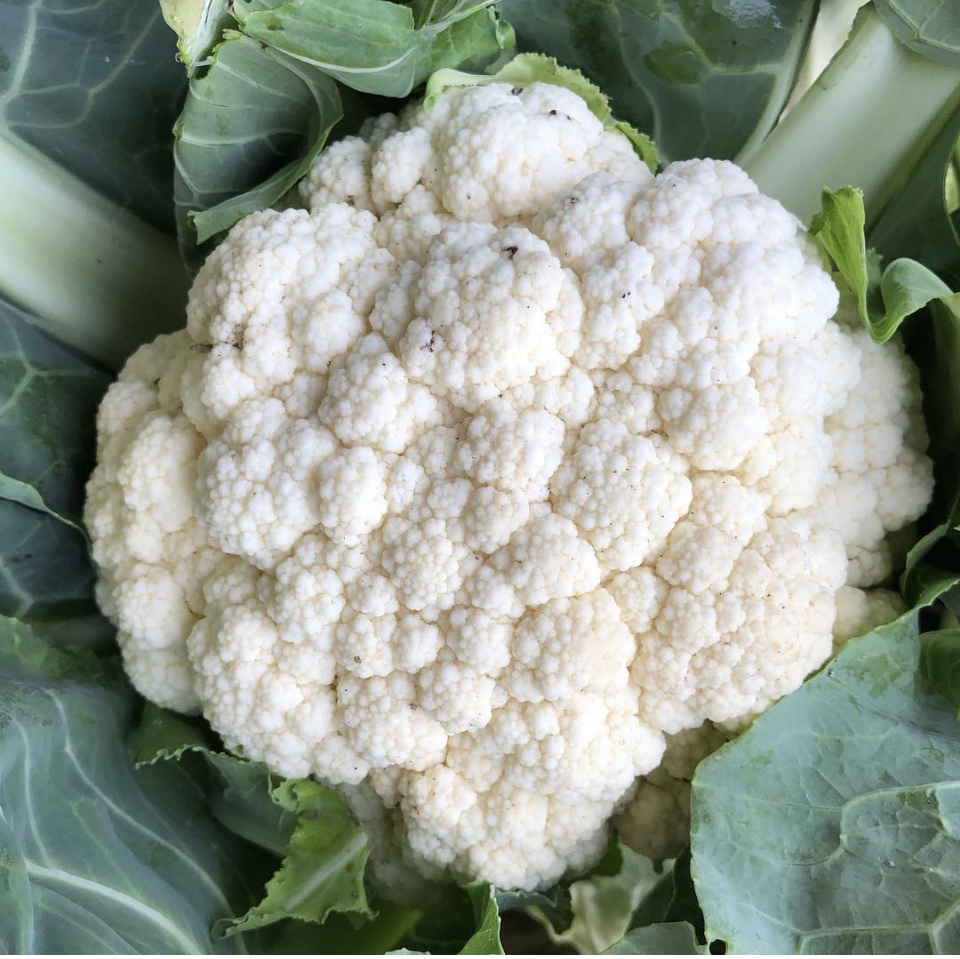
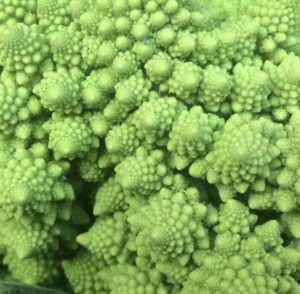 When I was a kid here in California cauliflower was white. Nowadays consumers can find many different forms and colors of cauliflower in the marketplace. At one extreme we have the green Fibonacci extravaganza that is the so-called “Broccoli Romanesco.” There’s another green cauliflower that has a more “typical,” rounded form to the head that’s marketed as “Broccoflower,” and then there are yellow cauliflower varieties and even purple cauliflower types. It’s been interesting to see these different breeds of cauliflower become available, but today I want to talk about the old-fashioned white cauliflower and the efforts growers took (and still take) to keep the face of this iconic vegetable as white as consumers demand.
When I was a kid here in California cauliflower was white. Nowadays consumers can find many different forms and colors of cauliflower in the marketplace. At one extreme we have the green Fibonacci extravaganza that is the so-called “Broccoli Romanesco.” There’s another green cauliflower that has a more “typical,” rounded form to the head that’s marketed as “Broccoflower,” and then there are yellow cauliflower varieties and even purple cauliflower types. It’s been interesting to see these different breeds of cauliflower become available, but today I want to talk about the old-fashioned white cauliflower and the efforts growers took (and still take) to keep the face of this iconic vegetable as white as consumers demand.
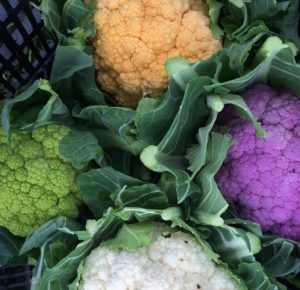 Cauliflower is a form of Brassica oleracea, along with seemingly disparate and different crops like cabbage, kale, collards, kohlrabi, and Brussels Sprouts. And just as there is an amazing diversity of forms among the members of the Brassica oleracea family, there is a very wide range of traits to be discovered just among the cauliflowers. I’ve walked a lot of miles down rows of cauliflower, looking down, peering into their faces, judging when we ought to pick the crop, and I’ve seen plenty of so-called white cauliflowers that had hints of pink or purple, green, orange, or even brown showing in the face. Sometimes, I’ve seen cauliflowers that showed all these colors at once which was curious, if not appealing. Sometimes these colors are expressions of latent traits in the plants’ DNA. Plant scientists have seized the hidden potential locked up in the genetics to select and breed for a rainbow of varieties that express clear, bright colors. Other times the “off-brand” colors in white cauliflower betrays some environmental stress that the plant has endured, like too much sun, heat, or drought.
Cauliflower is a form of Brassica oleracea, along with seemingly disparate and different crops like cabbage, kale, collards, kohlrabi, and Brussels Sprouts. And just as there is an amazing diversity of forms among the members of the Brassica oleracea family, there is a very wide range of traits to be discovered just among the cauliflowers. I’ve walked a lot of miles down rows of cauliflower, looking down, peering into their faces, judging when we ought to pick the crop, and I’ve seen plenty of so-called white cauliflowers that had hints of pink or purple, green, orange, or even brown showing in the face. Sometimes, I’ve seen cauliflowers that showed all these colors at once which was curious, if not appealing. Sometimes these colors are expressions of latent traits in the plants’ DNA. Plant scientists have seized the hidden potential locked up in the genetics to select and breed for a rainbow of varieties that express clear, bright colors. Other times the “off-brand” colors in white cauliflower betrays some environmental stress that the plant has endured, like too much sun, heat, or drought.
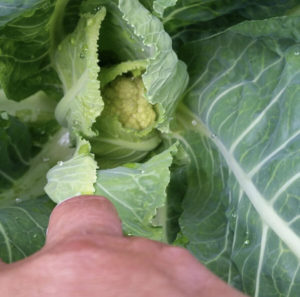 For a commodity crop available on almost any supermarket shelf, cauliflower is fussy to grow. The plant likes very rich soil, lots of water and a cool climate. Most of the US does not enjoy these conditions, or at least not for much of the year, so large-scale commercial production for the whole nation is centered along California’s central coast, where summers are cool. It may be typically foggy in the Salinas or Pajaro Valleys but if we have an extended period of sunny hot weather cauliflower crops can be prompted to mature so fast that the plants are stressed, and this stress can show as “discoloration” in the face. In an effort to keep the cauliflower white growers sometimes gather the big, floppy leaves of the cauliflower plant together and bind them up tight with a rubber band. Of course, this added step in cauliflower production adds costs. Another measure a grower can take to blanch cauliflower is to simply have a farmworker break or fold a big leaf over the open face of the plant to shade it.
For a commodity crop available on almost any supermarket shelf, cauliflower is fussy to grow. The plant likes very rich soil, lots of water and a cool climate. Most of the US does not enjoy these conditions, or at least not for much of the year, so large-scale commercial production for the whole nation is centered along California’s central coast, where summers are cool. It may be typically foggy in the Salinas or Pajaro Valleys but if we have an extended period of sunny hot weather cauliflower crops can be prompted to mature so fast that the plants are stressed, and this stress can show as “discoloration” in the face. In an effort to keep the cauliflower white growers sometimes gather the big, floppy leaves of the cauliflower plant together and bind them up tight with a rubber band. Of course, this added step in cauliflower production adds costs. Another measure a grower can take to blanch cauliflower is to simply have a farmworker break or fold a big leaf over the open face of the plant to shade it.
Does the world end if a cauliflower face isn’t as white as snow?
No.
Left to its own devices, a cauliflower head will mature under the sun, with each of the so-called “curds” lengthening into a longer stem. Eventually, these stems morph into long flower stalks, each topped with a little broccoli-like flower bud. When the flowers open, they show off clusters of the typical 4 petaled propeller shaped blooms common to all members of the Brassica oleracea. If you discount the cosmetic demands that the American consumer makes on the presentation of the crop, cauliflower is edible- and indeed delicious- at every stage of development. The store wants uniformly sized, tight, white heads to display so that the vegetable can be sold by the piece and cauliflower heads that are opening in different sizes, shapes, and colors are not desired. But the looser heads of opening cauliflowers taste good, even if they seem discolored to an eye that expects white. I’ve found that the little, broccolli-like florettes that develop right before the plant bursts into bloom can be sweeter than the tight cauliflower head that they sprang from ever was.
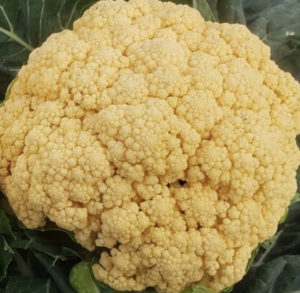 Plant scientists developed many different forms of cauliflower to appeal to different consumers, but also to different growers. The yellow cauliflowers show off their best color when the developing crop does get some sun to bring out and deepen the gold color, and these varieties do well for inland growers who can’t expect to have consistently overcast conditions. Purple cauliflower doesn’t seem to mind the sun so much either. I’ve grown all the different kinds of cauliflower at one time or another, and I’ve found the green “Brocco-flower” types to be the fussiest and most difficult. For me, the green cauliflower types work best as an early fall-plant crop for midwinter harvest, when we can be more sure that the weather will be cool and moist.
Plant scientists developed many different forms of cauliflower to appeal to different consumers, but also to different growers. The yellow cauliflowers show off their best color when the developing crop does get some sun to bring out and deepen the gold color, and these varieties do well for inland growers who can’t expect to have consistently overcast conditions. Purple cauliflower doesn’t seem to mind the sun so much either. I’ve grown all the different kinds of cauliflower at one time or another, and I’ve found the green “Brocco-flower” types to be the fussiest and most difficult. For me, the green cauliflower types work best as an early fall-plant crop for midwinter harvest, when we can be more sure that the weather will be cool and moist.
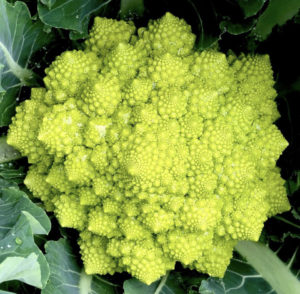 The Romanesco types have been changed the most in my experience. In the past the Romanesco seed we bought gave us wildly different plants, some huge with tiny heads, and they took a long time to develop, but now Romanesco varieties are very uniform- so uniform, in fact, that the crops all seem to mature at once. Having a whole crop come off at once is a boon to a large scale grower who is machine harvesting whole fields in a day but it can be a problem for small growers, like myself, who would like to harvest more modest amounts out of the same patch over a longer time period to satisfy a smaller, local market with a consistent supply. With the old fashioned white cauliflower we were able to plant a big block all at once and harvest out of it for a while. With the improved types we have to plant more numerous small blocks that are harvested clean and turned over. This can be cumbersome and hard to manage.
The Romanesco types have been changed the most in my experience. In the past the Romanesco seed we bought gave us wildly different plants, some huge with tiny heads, and they took a long time to develop, but now Romanesco varieties are very uniform- so uniform, in fact, that the crops all seem to mature at once. Having a whole crop come off at once is a boon to a large scale grower who is machine harvesting whole fields in a day but it can be a problem for small growers, like myself, who would like to harvest more modest amounts out of the same patch over a longer time period to satisfy a smaller, local market with a consistent supply. With the old fashioned white cauliflower we were able to plant a big block all at once and harvest out of it for a while. With the improved types we have to plant more numerous small blocks that are harvested clean and turned over. This can be cumbersome and hard to manage.
The different colored cauliflowers all have their advantages and positive traits but the seed is awfully expensive. As an economical crop to grow, the white cauliflowers are usually the best bet. If we want smaller sized heads we’ll crowd more plants in the row. You can space cauliflowers out and give them lots of fertilizer and they’ll grow as big as car tires, but what’s the point? I like to have smaller cauliflower and I like to leave more of the wrapper leaves on the head than you see in the supermarket because the leaves help to protect the tender face from bruising. Then too, the wrapper leaves are edible- no different really than kale or collards; the consumers in the know cut the leaves up and cook them.
Spring is a nice time to harvest cauliflower, but we’re still planting more crops that will mature in early summer. We’re getting the tomatoes and basil into the ground right now, but a person can’t live off of tomatoes and basil alone, even if it’s tempting to try. And the warming weather we’re experiencing right now should bring on the artichoke crop too.
© 2021 Essay and Photos by Andy Griffin.


